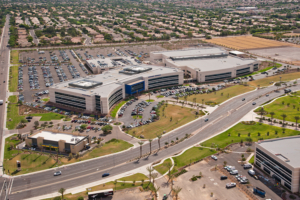After more than a quarter century in commercial real estate, Todd Holzer, chairman of NAIOP-AZ, has been witness to many industry ups and downs.
Holzer began his career with Opus Southwest in Phoenix and San Diego. After 12 years at Opus, he moved on to DeRito Partners, where he spent eight years developing retail projects. Now in his sixth year at Ryan Companies US Inc., specializing in office and industrial projects and overall marketing for its Southwest regional operation, Holzer says market conditions in Arizona make for some intriguing times.
“Two things that I find interesting about our local market: First, the volatility of the Metro Phoenix market has to be among the greatest of all major U.S. markets,” Holzer says. “It seems that in my career, the overall market conditions for office and industrial have either been on fire or in the dumps. There are days I wish we were a little more steady, like some other Ryan offices in the Midwest. The feast-or-famine scenario we have can be an emotional and economic roller coaster for those in the business.
“Secondly, and again unfortunately, I always think about what could have been a very cool, relevant Downtown Phoenix. Despite some good vision out of the City of Phoenix political leaders, we are still a metro area that has grown outward with sprawl. I wonder if true urbanism can happen here. Most people live here to take advantage of activities that are suburban in nature: golf, hiking and other outdoor activities that don’t occur in a downtown setting.”
Holzer takes the reins at NAIOP-AZ during rocky economic times, but he says he is up to the challenge. When he started at Opus, he joined NAIOP-AZ mainly for networking purposes.
“When I moved into retail development, I spent more time and energy in other organizations such as ICSC, Valley Partnership and ULI,” he says. “But when I came to Ryan with an office and industrial focus, I decided that I needed to get back into NAIOP and take on a leadership role.”
Holzer has been on NAIOP’s local board of directors for five years and on the national board for three. After about two years on the local board, he was asked to take on the time and challenge of training for his eventual role as chairman.
“I have served under a few visionary and hard-working chairmen that have given me the experience to run the local chapter in what are very challenging times,” he says.
Holzer is not one to dwell on the negative. Instead, he says focus should be put on the quality of projects being built today, including NAIOP-member LEED certification initiatives.
“I take my hat off to some developers in our market that build with quality and with vision,” he says. “RED Development building CityScape and SunCor building Hayden Ferry are great projects that went to a level that most developers would not go.
“In my opinion, there has not been an increase in the quality of office projects over the last 15 to 20 years. The granite exterior projects built in the ’80s and early ’90s have stood the test of time. Most developers don’t build true quality because they are building to the level requested by the tenant and user market, and tenant and user groups have been fixed upon cost rather than quality and amenities.
“On the other hand, industrial projects have been built in the last cycle to a much higher standard of function than in the past.”
Among those higher standards is building to LEED specifications and the move toward more energy-efficient projects. Nationally, Holzer says, NAIOP has become fully engaged in LEED initiatives by having educational events tied around the green movement, with the major event being an annual conference dedicated to energy-efficient development. Phoenix hosted the conference a few years ago.
“Locally, we are giving awards to the best energy efficient new development each year at our Best of NAIOP event,” he says.
Examples of recent projects, Holzer cites, are Liberty Property Trust and its Scottsdale building for Vanguard; Lincoln Property Company and the Arizona Game and Fish Department building; Ryan’s 3900 E. Camelback building; and Hines’ office building at 24th Street and Camelback. There also are numerous local municipal and higher-education projects that have been built to LEED standards.
For those in the commercial real estate industry preparing for the future, Holzer offers this advice:
“At the present time, our industry is going through a monumental change,” he says.
“Speculative development will not re-appear for approximately five years in the Valley, so new development will be way down and that side of the business will not be hiring. People and companies will need to reinvent themselves. Take your strengths and use them in different ways within our industry.
“We are still the fifth-largest city in the country and our role as a major place of commerce in the Western U.S. will continue to grow.”
Holzer predicts 2011 will be a sequel of 2009 and 2010; users and tenants are price sensitive and looking for deals.
“We are in a period where land, rents and construction costs are on sale,” he says. “Those with a long-term approach and sufficient funding can solve real estate needs at very attractive costs.”
Some of the biggest challenges Holzer sees in 2011 are lack of capital and nominal job growth. The industrial sector needs capital to be available to companies for expansion and purchasing of inventories and equipment, he says, and the office sector is tied to job creation.
“Unless we can get local and national job creation to pick up dramatically, high-vacancy rates and shadow space inventory will continue with us,” Holzer explains. “The main challenge facing most sectors of commercial real estate is the national political scene and the decisions coming out of Washington, D.C. There is too much uncertainty currently for small business owners to make real estate decisions.”



